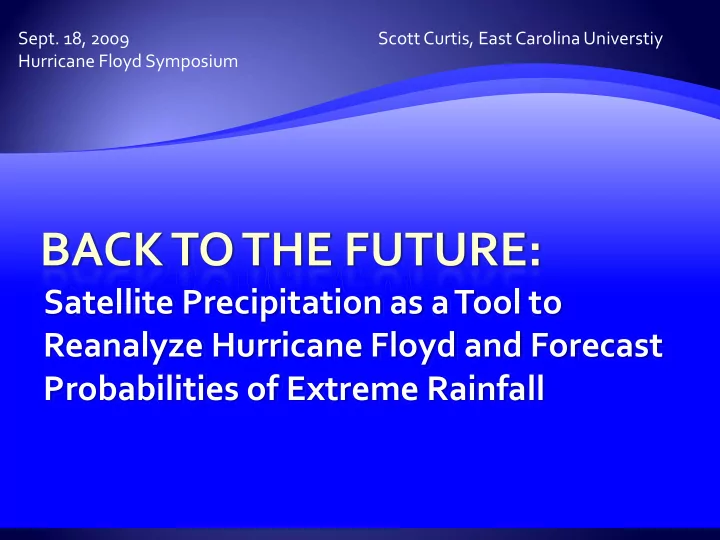

Sept. 18, 2009 Scott Curtis, East Carolina Universtiy Hurricane Floyd Symposium Satellite Precipitation as a Tool to Reanalyze Hurricane Floyd and Forecast Probabilities of Extreme Rainfall
� What was the freshwater input to the Tar, Neuse, and Cape Fear River basins? � Curtis, Crawford, Lecce in Nat Hazards (2007) 43:187 ‐ 198 � How much rain did Dennis and Floyd produce during their tracks? � Did more rain fall in Eastern North Carolina than anywhere else on the planet during Floyd?
� Satellites: � Tropical Rainfall Measuring Mission � daily precipitation data � Global Precipitation Climatology Project � pentad precipitation data � Ship, buoy, satellite blended sea surface temperature data � Kriged gauge data � Radar storm total
Truth?
ATTRIBUTE GUAGE – KRIGED RADAR (KRAX) TRMM Resolution: 0.25 km 2 Resolution: Resolution: Variable, 0.1 km 2 to 150.6 Approximately 625 km 2 km 2 Location of maximum Left of the storm track, near West of the gauge maximum Consistent with the gauge storm total Brunswick and Edgecombe in a near continuous band maximum, except counties from Cape Fear to additional maximum over Edgecombe county Lenoir county Discussion Location of the bulk of the precipitation is consistent with other published reports. Maxima in kriged analysis are dependent on the gauge locations. Maximum storm total 593 mm 381 mm 435 mm Discussion Minimum in the radar analysis is likely due to a) reporting storm totals in coarse increments of 0.5 to 2.0 inches; b) range-dependent biases. Extent of storm totals > From storm track west to Similar Extending from the coast to 150 mm (orange color) Lee and Vance counties the western edge of the Tar river basin Discussion The TMPA is biased high overall.
Volumetric rainfall x10 9 m 3 Discharge x10 9 m 3 Basin (bias % w/ gauge) TRMM RADAR GAUGE USGS Tar ‐ Greenville 2.12 (+6%) 1.91 ( ‐ 5%) 2.00 0.92 Neuse ‐ Ft. Barnwell 2.88 (+10%) 2.57 ( ‐ 2%) 2.61 0.92 Cape Fear ‐ Kelley 2.83 (+49%) 1.73 ( ‐ 9%) 1.90 0.47
� Curve numbers are based on empirical rainfall-runoff relationships � Q = (P - 0.2S) 2 / (P + 0.8S) and CN = 1000 / (S + 10); where Q = discharge, P = precipitation, S = maximum retention, and assuming initial abstraction is 20% of S. � CN 55, which fits the gauge and radar data reasonably well represents woodlands in good hydrologic condition. TMPA curve numbers are lower. Thus, if we had global CN numbers, they could be adjusted to account for the difference � Hong et al. (2007) extended this work by deriving global CN numbers from remotely sensed data sets of soil and land use.
TRMM gauge TAR NEUSE CAPE FEAR radar
Hong et al. (2007)
� (Shepherd et al. 2007, Lau et al. 2008) Greenville received a total of 23.29 inches of rain from 24 August to 17 September
23.29 Cindy Emily Floyd Dennis
Time variation of cumulative extreme TC rainfall to total rainfall in the top 10 percentile of observations from the Global Precipitation Climatology Project pentad rainfall product (solid line). Dotted line shows the normalized anomaly in percentage of warm pool area (> 28 C) over Jul-Aug- Sep-Oct-Nov season for each year (Lau et al. 2008).
NC/VA � GPCP pentad September 13 ‐ 17 1999 � 38.6988 mm/day (or 7.6 inches) 144 x 72 = 10,368
� NC/VA was the 4 th rainiest grid box for the pentad September 13 to 17, 1999 � More rain occurred near the Bahamas, associated with Floyd, and in the southeastern Pacific
� NC/VA has only been ranked in the top ten 3 pentads out of 2117 (from 1979 to 2007) � 2 nd : Aug 24 ‐ 28 2006 associated with Hurricane Ernesto � 4 th : Sep 13 ‐ 17 1999 associated with Hurricane Floyd � 5 th : Sep 23 ‐ 27 1985 associated with Hurricane Gloria
� Rankings are an objective and homogeneous measure of “relative climate change” � The methodology can be used to answer the question: Is a location contributing more or less to global extreme weather? � Climate change results will be presented at the Carolinas and Virginia Climate Conference October 20 ‐ 21, 2009
� Best agreement between Gauge*, Radar, and Satellite over the Tar River Basin: � 1.91 to 2.12 km 3 of water (larger than Lake Norman) � Tropical Rainfall Measuring Mission satellite shows large swath of precipitation in the Atlantic of the same magnitude as recorded in North Carolina (Cindy + Dennis + Emily + Floyd) � Floyd rainfall was extreme in a global sense � NC/VA achieved similar rankings in the past from August to September associated with tropical cyclones. Could these rankings be helpful for projecting into the future?
Recommend
More recommend